
Umangite is a copper selenide mineral, Cu3Se2, discovered in 1891. It occurs only in small grains or fine granular aggregates with other copper minerals of the sulfide group. It has a hardness of 3. It is blue-black to red-violet in color with a black streak. It has a metallic luster.

Tiemannite is a mineral, mercury selenide, formula HgSe. It occurs in hydrothermal veins associated with other selenides, or other mercury minerals such as cinnabar, and often with calcite. Discovered in 1855 in Germany, it is named after Johann Carl Wilhelm Tiemann (1848–1899).

Clausthalite is a lead selenide mineral, PbSe. It forms a solid solution series with galena PbS.
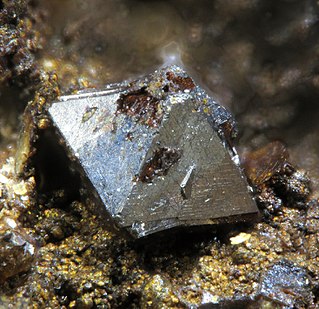
Polydymite, Ni2+Ni23+S4, is a supergene thiospinel sulfide mineral associated with the weathering of primary pentlandite nickel sulfide.

Carrollite, CuCo2S4, is a sulfide of copper and cobalt, often with substantial substitution of nickel for the metal ions, and a member of the linnaeite group. It is named after the type locality in Carroll County, Maryland, US, at the Patapsco mine, Sykesville.

Penroseite is a rare selenide mineral with formula (Ni,Co,Cu)Se2. It has a gray-steel color and black streak with a hardness of 3. It is an isometric mineral, 2/m3. Penroseite was first discovered in 1925 in a Bolivian rhyolite. It was named for Richard Penrose (1863–1931), an economic geologist.

Linnaeite is a cobalt sulfide mineral with the composition Co+2Co+32S4. It was discovered in 1845 in Västmanland, Sweden, and was named to honor Carl Linnaeus (1707–1778).
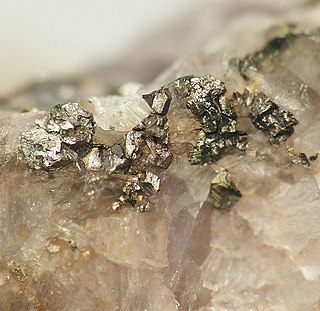
Cattierite (CoS2) is a cobalt sulfide mineral found in the Democratic Republic of Congo. It was discovered together with the nickel sulfide vaesite by Johannes F. Vaes, a Belgian mineralogist and named after Felicien Cattier, who was chairman of the board of the Union Minière du Haut-Katanga.
Fletcherite is a rare thiospinel sulfide mineral with formula Cu(Ni,Co)2S4. It is an opaque metallic steel gray mineral which crystallizes in the cubic crystal system. It is a member of the linnaeite group.

Athabascaite is a member of the copper selenide minerals, and forms with other copper selenides. It was first discovered by S. Kaiman in 1949 while he was researching radioactive materials around Lake Athabasca. Kaiman was conducting research near Uranium City, Saskatchewan where mass amounts of uranium mines were present.
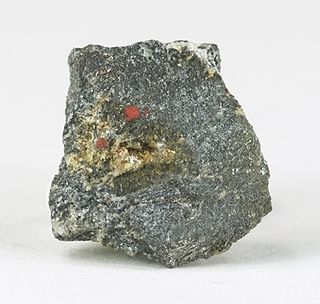
Bukovite is a rare selenide mineral with formula Tl2Cu3FeSe4. It is a brown to black metallic mineral which crystallizes in the tetragonal system.
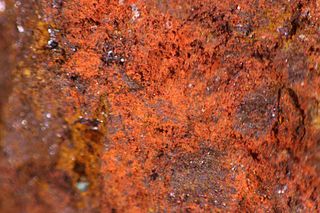
Coccinite is a rare mercury iodide mineral with chemical formula of HgI2, mercury(II) iodide. It was first discovered in Casas Viejas, Mexico; it has also been reported from Broken Hill, New South Wales, and from a uranium mine in Thuringia and old mercury workings in the Rhineland-Palatinate in Germany. At the Thuringia deposit the mineral occurs as a sublimation product resulting from fires associated with pyrite-bearing graptolitic slate.
Chrisstanleyite, Ag2Pd3Se4, is a selenide mineral that crystallizes in high saline, acidic hydrothermal solution at low temperatures as part of selenide vein inclusions in and alongside calcite veins. It tends to be found in assemblages of other selenides: jagueite, naumannite, fischesserite, oosterboschite, and tiemannite, and it is a solid solution mineral with jagueite Cu2Pd3Se4 in which it shares a unique crystal structure that has not been identified elsewhere (Paar et al. 1998; Nickel 2002; Paar et al. 2004). Chrisstanleyite and jagueite are unlike the other minerals of the selenide family as they do not have a sulfide analogue (Topa et al. 2006). First discovered by Werner Paar from a sample received from Hope's Nose, Torquay, Devon, England, chrisstanleyite has since been discovered in the Pilbara region of Western Australia and in El Chire, La Rioja, Argentina. Chrisstanleyite was named after the Deputy Head and Associate Keeper at the Department of Mineralogy at The Natural History Museum in London.
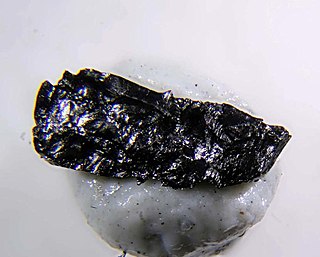
Achávalite is a selenide mineral that is a member of the nickeline group. It has only been found in a single Argentinian mine system, being first discovered in 1939 in a selenide deposit. The type locality is Cacheuta mine, Sierra de Cacheuta, Mendoza, Argentina.

Kruťaite, simplified Krut'aite or krutaite, is a rare mineral with the formula CuSe2. It crystallises in the cubic crystal system. It is part of the pyrite group, being composed of Cu2+ ions and Se22− ions. The mineral is most often found as a dark grey aggregate consisting of tiny crystals no more than a millimeter in size. The crystals are opaque in any size. It has no industrial use, but it is a prized collector's item.
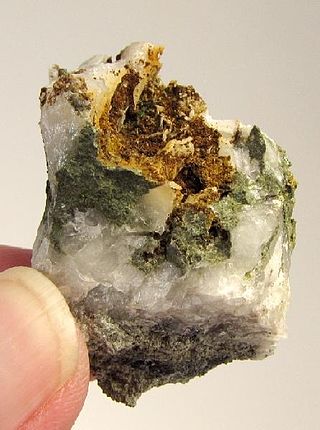
Trogtalite is a rare selenide mineral with the formula CoSe2. It crystallizes in the cubic system and is part of the pyrite group, consisting of Co2+ and Se22− ions. It has a rose-violet colour and its crystals are opaque. It often occurs as grains. It was thought to be dimorphous with hastite, but this was discredited in 2009. Hastite turned out to be the iron selenide mineral ferroselite. It forms a solid solution series with kruťaite.

Berzelianite is a rare copper selenide mineral with the formula Cu2Se. It occurs as thin dendritic crusts or as fine-grained inclusions. It crystallizes in the isometric system, unlike its dimorph, bellidoite, which crystallizes in the tetragonal system. The crystals are opaque and slightly malleable.
Eskebornite is a selenide mineral with the formula CuFeSe2. It crystallizes in the tetragonal system and it has a brassy colour. Eskebornite is sometimes found as thick tabular crystals, but is more often found intergrown with other selenides. It is part of the chalcopyrite group and forms a series with chalcopyrite.

Oosterboschite is a rare selenide mineral with the formula (Pd,Cu)7Se5. It crystallises in the orthorhombic crystal system. It has a creamy yellow colour and a Moh's hardness of 5. It is often found as grains with no clear shape. The crystals are opaque and often no bigger than 0.4 mm.
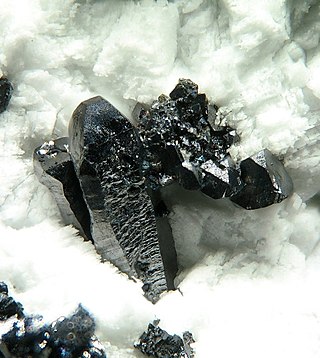
Villamanínite is a copper sulfide mineral with small amounts of other elements, belonging to group II according to the Strunz classification. It was discovered in 1920 when studying the copper minerals of the Providencia mine in the municipality of Cármenes, León (Spain). The English researchers who identified it gave it the name of villamaninite when they confused the municipality in which the mine was actually located, because Villamanín is where the ore was loaded onto the railroad for export.

















